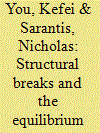| Srl | Item |
| 1 |
ID:
131398


|
|
|
|
|
| Publication |
2014.
|
| Summary/Abstract |
The paper considers the optimal transition path for China's exchange rate regime. How can China successfully make the shift from the current dollar peg regime to a more desirable regime, whether a basket peg or a floating regime? To answer this question, we develop a dynamic small open economy general equilibrium model. We construct four transition policies based on a basket peg or a floating regime and compare the welfare gains of these policies relative to maintaining the dollar peg regime. Two main results are derived from the quantitative analysis using Chinese data from 1999Q1 to 2010Q4. First, following a gradual adjustment to a basket peg regime is the most appropriate path for China to take, with minimal welfare losses associated with the shift in the exchange rate regime. Second, a sudden shift to the basket peg is the second best solution, and is superior to a sudden shift to floating because the monetary authority can efficiently determine optimal weights to attach to currencies in the basket to achieve policy goals once they adopt a basket peg regime.
|
|
|
|
|
|
|
|
|
|
|
|
|
|
|
|
| 2 |
ID:
187892


|
|
|
|
|
| Summary/Abstract |
Using a novel panel data method proposed by Hisao, Ching and Wan (2012), we empirically evaluate the misalignments between the actual and counterfactual values of Chinese real effective exchange rate (REER, CPI-based) from 1994 to 2020, where “counterfactual” refers to the counterfactual scenarios that some major economic events had not happened. These events include China's accession to WTO from December 2001, the reforms of exchange rate regime in July 2005, June 2010 and August 2015, China's economic stimulus package in November 2008, and the US-China trade dispute started from March 2018. We calculate the counterfactual values for both real and nominal effective exchange rates (REER and NEER) in order to examine the channels of the misalignments. We find that the reform of China's exchange rate policy in July 2005 and August 2015 increased Renminbi's trade competitiveness in real term compare to foreign currencies, while other events decreased it or had no effects. The misalignments in REER are caused by the changes in both NEER and China's CPI.
|
|
|
|
|
|
|
|
|
|
|
|
|
|
|
|
| 3 |
ID:
116534


|
|
|
|
|
| Publication |
2012.
|
| Summary/Abstract |
This paper investigates the equilibrium real effective exchange rate for the Chinese RMB during the post-reform period, 1982-2010. We extend the NATREX model in several important perspectives and apply it for the first time to China. A wide range of economic fundamentals that are unique to the Chinese economy is introduced into the model. We construct a unique set of quarterly data and employ unit root and cointegration tests that can account for multiple endogenous structural breaks. In addition, to capture the evolution of China's foreign trade pattern, we employ time-varying (i.e. 3-year average) trade weights to construct the real effective exchange rate. We find two structural breaks in the cointegration relationship (in 1988 and 1992). Effective terms of trade, demographic factors, liquidity constraints and government investment are significant determinants of the equilibrium real effective exchange rate. The RMB was overvalued against a basket of 14 currencies until mid-1980s. During 1986-2010, it was undervalued in most years except after the Asian financial crisis in 1997. We have found persistent undervaluation from 2004 onwards. However, the misalignment rates are much lower than those reported by previous studies and the undervaluation rate actually declined sharply in 2008. The undervaluation rate rose modestly in 2009 and sharply in 2010, though it is still lower than what has been suggested by other studies.
|
|
|
|
|
|
|
|
|
|
|
|
|
|
|
|